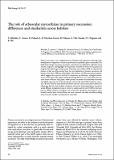Por favor, use este identificador para citar o enlazar a este item:
http://hdl.handle.net/10261/164795COMPARTIR / EXPORTAR:
 SHARE SHARE
 CORE
BASE CORE
BASE
|
|
| Visualizar otros formatos: MARC | Dublin Core | RDF | ORE | MODS | METS | DIDL | DATACITE | |

| Título: | The role of arbuscular mycorrhizae in primary succession: differences and similarities across habitats |
Autor: | Kikvidze, Zaal CSIC ORCID; Armas, Cristina CSIC ORCID ; Fukuda, K; Martínez-García, Laura Beatriz CSIC ORCID CVN; Miyata, M.; Oda-Tanaka, A.; Pugnaire, Francisco I. CSIC ORCID ; Wu, B. | Fecha de publicación: | 30-dic-2010 | Editor: | European Ecological Federation | Citación: | Web Ecology 10:50-57 (2010) | Resumen: | Primary succession is an ecological process of fundamental importance referring to the development of vegetation on areas not previously occupied by a plant community. The bulk of knowledge on primary succession comes from areas affected by relatively recent volcanic eruptions, and highlights the importance of symbiosis between host plants and fungi for the initial stages of succession. Arbuscular mycorrhizas (AM) are of particular interest as they are often present from the very beginning of primary succession and because they show different relationships with pioneer and late-successional species, which suggests they may be involved in important, yet unknown, ecological mechanisms of succession. We review existing knowledge based on case studies from the volcanic desert of Mount Fuji, Japan, where primary succession was examined intensively and which represents one of the best-known cases on the role of AM in primary succession. We also assess the potential of sand dunes and semi-arid, erosion-prone systems for addressing the role of mycorrhizas in primary succession. Analyzing primary succession under different ecological systems is critical to understand the role of AM in this basic process. While volcanoes and glaciers are restricted to particular mountainous areas, naturally eroded areas and sand dunes are more common and easily accessible, making them attractive models to study primary succession. | Versión del editor: | https://doi.org/10.5194/we-10-50-2010 | URI: | http://hdl.handle.net/10261/164795 | DOI: | 10.5194/we-10-50-2010 | ISSN: | 1399-1183 |
| Aparece en las colecciones: | (EEZA) Artículos |
Ficheros en este ítem:
| Fichero | Descripción | Tamaño | Formato | |
|---|---|---|---|---|
| 2011 Kikvidze et al. WebEcol.pdf | 784,31 kB | Adobe PDF |  Visualizar/Abrir |
CORE Recommender
SCOPUSTM
Citations
19
checked on 18-abr-2024
Page view(s)
314
checked on 18-abr-2024
Download(s)
171
checked on 18-abr-2024
Google ScholarTM
Check
Altmetric
Altmetric
Este item está licenciado bajo una Licencia Creative Commons

